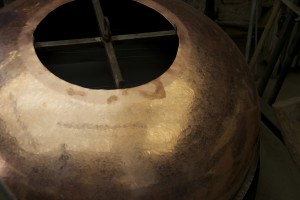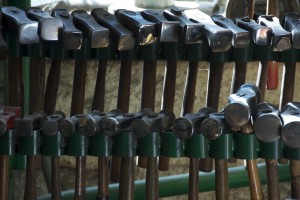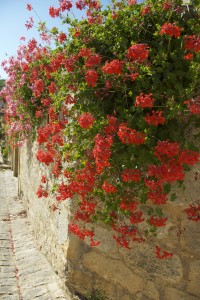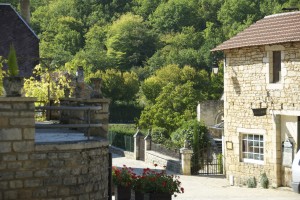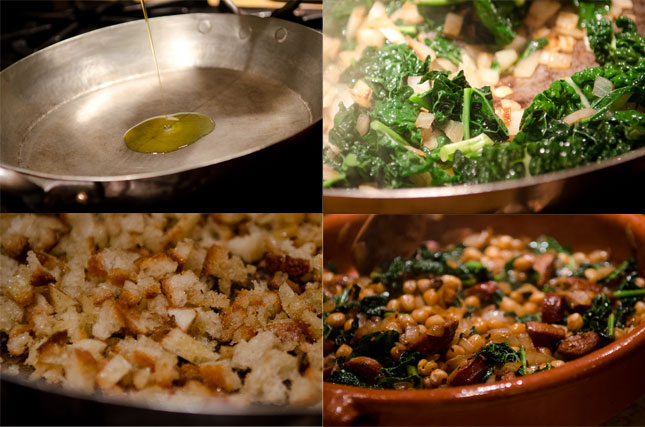The Dinandier’s Chick peas, Chorizo and Cavolo Nero
French copper pots cook the best food. Every good kitchen needs one. Not only elegant and beautiful, they hold a steady heat and build a dish’s depth and character. So I went to France to collect one.
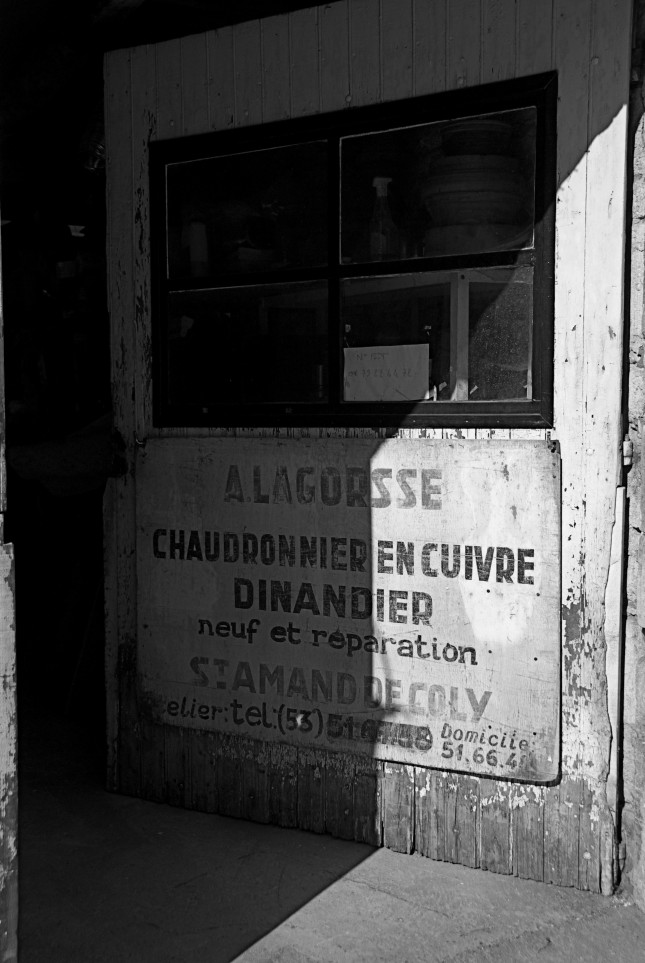
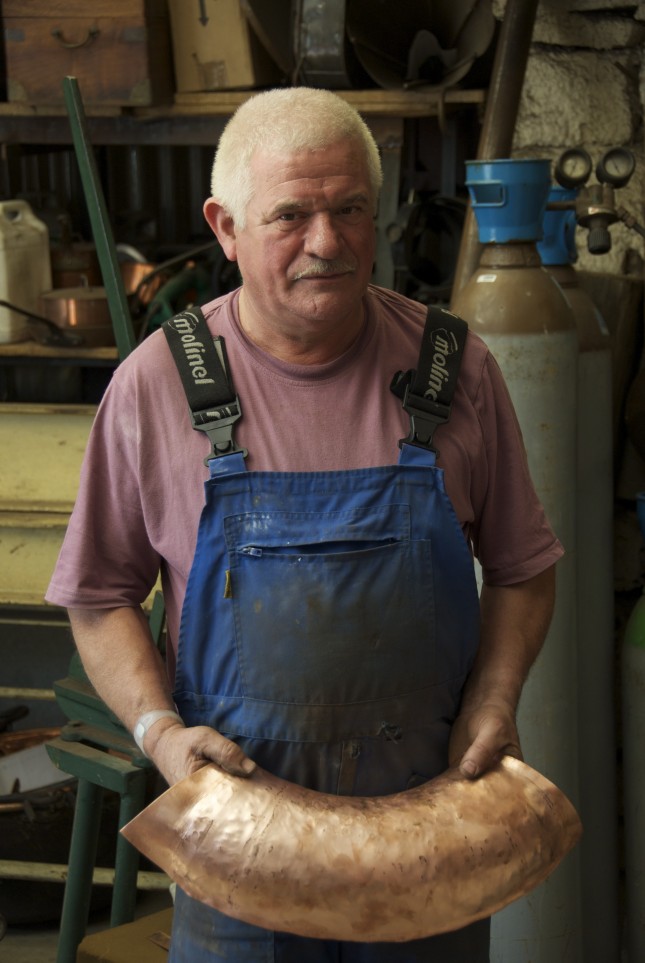 St. Amand De Coly is a quaint, picture perfect, tiny village in the upper Dordogne region of France. Home of the humble, non-English speaking Dinandier, Alain Lagorsse. He is an “Artisan of Art,” or a brazier who makes functional and decorative objects out of copper and tin. My guy. I reseached him before we left, and didn’t really expect to make it all happen. I wasn’t really going just for the copper pot.
St. Amand De Coly is a quaint, picture perfect, tiny village in the upper Dordogne region of France. Home of the humble, non-English speaking Dinandier, Alain Lagorsse. He is an “Artisan of Art,” or a brazier who makes functional and decorative objects out of copper and tin. My guy. I reseached him before we left, and didn’t really expect to make it all happen. I wasn’t really going just for the copper pot.
Because it was within an hour’s drive North of Sarlat, and much more fun to meet the atisan in person instead of buying a piece from the reputably arrogant Parisian sellers of stellar chef ware, Dehillerin, we were determined to go. We started our day wandering the narrow, cobbled streets of Sarlat, the swashbuckling town of the almost 1000 year old Saturday Market. Do you need more of a reason to go? The food was outstanding-everything you could ever want in season, and then all the cheeses, olives, meats, the famed foie gras…and so it goes in Sarlat. But that’s the background story. I was talking about Alain, the Dinandier. I digress, but worth so much more conversation..
We left the market with choice goods, heading North, and settled on a south facing slope of some farmers field to enjoy our reparte while it was all so awesomely fresh. No napkin? Not to worry, we had a pair of cotton boxers conveniently nearby. Yes, they were clean and in the suitcase that we had with us as we were moving from one week long spot to another. Lucky us. But wait, I digress…
We fell upon this storybook picture village of golden brick, blooming bougainvillaea spilling out over ancient walls, and lovely, grand scale church- all framing the dark, dust mote filled ting ting ting sound of the workshop we peeked into. Who would have thought?
What I could make out among the dim, tool filled corners stocked with all types of copper pieces and partially assembled stills, was basically two rooms, one for making, one for objects des arts. I learned Alain spent most of his time fabricating German stills. They were beautiful, but I thought he was making a selection of outstanding pots just for me. I came to meet him. I was given two choices. Two choices? A two-handed-only sauce pan, no thanks, or the wide and shallow, I-can-braise-anything-and-do-so-many-amazing-things-for-you-if-you-just-let- me, two handled pan. I chose that one. It called to me and it was beautiful. Merci Alain.
What to make with this gem? Well now, almost anything. But a good example of its talents is in allowing all items to get a front row seat at the fire. All ingredients toast up quickly and you can layer in a complete assembly in a short amount of time. Wide and shallow pans like this, really build the flavors, layer by layer, and create the character of a dish. Trying to cook up the same amount of ingredients in a narrower pan takes too many batches to keep the food sauteeing, and not braising. So, this is a pan designed to feed the dinner gathering, not suitable for solo ventures.
A mid winter favorite uses some pantry staples and a solid garden green, Cavolo Nero or Lacinato kale and bakes into a dry style gratin. Try the leftovers with a soft egg, and a glass of sherry. I used some leftover cooked chickpeas, and I picked up the Chorizo from Olympic Provisions on NW Thurman. I bought two different styles, one smoked and dried and the other fresh. The combination was fun. And they are really good. The breadcrumbs I had in the freezer, very convenient.
Chick Peas, Chorizo and Cavolo Nero
Because the technique for this dish uses a wide bottomed pan, use the best pan for the job that you may have-a cast iron pan would be a good choice, or an enameled cast iron dutch oven. Please use the amounts in this recipe as guidelines only, adjusting or substituting the ingredients as well. The method is what’s important. It’s a casual and comfort-minded dish, meant to satisfy on a quiet solo night, or a full gathering at the Sunday table.
5 cloves garlic, smashed
1 red onion, small diced
1/2 tsp. dried red chiles, sliced
1 tsp. dried thyme
salt and pepper
1 bunch kale, washed, dried and sliced into bite-sized pieces
1/2 cup dry white wine
2 Chorizo sausages, sliced
2 cups cooked and dry chick peas
2 T. butter
2 cups fresh breadcrumbs
Manchego or goat cheese
Set your pan to heat on med. high for about 1 minute. When it is hot, add 1/4 cup of the olive oil. Let the oil get hot for another minute, then add the garlic cloves and swirl them around in the hot oil. When they begin to brown at the edges, remove them and set them aside to add later. You are flavoring the oil now only. Immediately add the onion all at once, then the chiles and saute until the onion is a light golden color, about 5-10 minutes. Add the thyme, reserved garlic and stir. season with salt and pepper. Now put in the kale and stir well. After about 5 minutes, stirring gently, add the wine and scrape up any carmelized pieces. When the wine has just evaporated, transfer the onion kale mixture to a cazuela or earthenware dish to a warmed 300 oven.
In the same pan, add a T. of oil and sate the Chorizo until just crisp on the outside edges. Remove to the warmed dish and stir together. Keep warm. Add another T. oil to the hot pan and add your chickpeas. Season them with salt and pepper. Fry until crispy, about 10 minutes. Add these to the warm dish in the oven. Now add the remaining 2 T. oil to the pan, along with the butter and let them sizzle together to blend. The butter adds flavor and extends the smoking point of the oil. Saute the breadcrumbs in this mixture for about 5-7 minutes, or unitl they are golden. Sprinkle them over the warm dish and serve with a soft goat cheese, or grated Manchego. Don’t forget the sherry.
